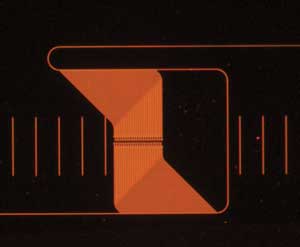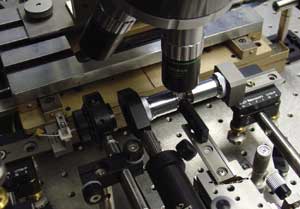Compiled by Photonics Spectra staff
To replace big, bulky, high-resolution spectrometers,
scientists have developed a microspectrometer that uses resonators shaped like a
compact disc to achieve high resolution.
Spectrometers have conventionally been expensive, bulky benchtop
instruments used to detect and identify the molecules inside a sample by shining
light on it and measuring different wavelengths of the emitted or absorbed light.
Although previous attempts to minimize spectrometers reduced their size and cost,
they also reduced the resolution.

A micrograph shows a microspectrometer developed by Ali Adibi and colleagues at Georgia
Institute of Technology. The instrument achieved 0.6-nm resolution over
a spectral range of more than 50 nm with a footprint ,1 mm2. Images courtesy of Zhixuan Xia.
Now, engineers at Georgia Institute of Technology have designed
an on-chip spectrometer with 81 channels that can achieve 0.6-nm resolution over
a spectral range of >50 nm with a footprint <1 mm2. They achieved high resolution
and wide bandwidth with a compact single-mode on-chip spectrometer through the use
of an array of microdoughnut resonators, each with an outer radius of 2 µm.
With its ultrasmall footprint, the device easily could be integrated
with sensors, optoelectronics, microelectronics and microfluidic channels for use
in biological, chemical, medical and pharmaceutical applications. The device was
described in the June 20 issue of Optics Express (doi: 10.1364/OE.19.012356).
The miniaturized microdoughnut resonators are essentially microdiscs
perforated in the centers. The researchers adjusted the resonance wavelength of
various resonators by engineering their geometry, and fine-tuned the devices by
adjusting the inner radius. Each resonator was designed so that it tapped only a
small portion of the incoming spectrum, enabling measurement of the entire spectrum
of desired wavelength in real time.

This experiment setup is used to test the 81-channel on-chip microspectrometer.
The new design enables scientists to independently control and
configure the resolution and operating bandwidth of each channel for different applications.
The device can cover a range of wavelengths from ~1 to 3 µm. Scientists say that
extending the concept to the silicon nitride platform could enable spectrometers
for visible light applications.
The group is developing the next generation of the spectrometers,
which will be designed to contain up to 1000 resonators and achieve 0.15-nm resolution
with a spectral range of 150 nm and a footprint of 200 mm2.